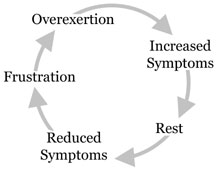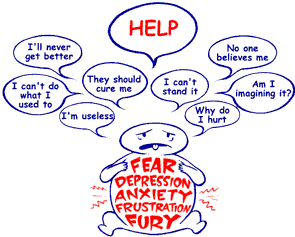Chronic pain is often difficult to define. Different therapists and researchers will define it as pain lasting longer than 6 weeks, some over 3 or 6 months. What it means is pain that lasts for longer than the original injury (if there was one) would normally be expected to cause painful symptoms.
The theory of what happens is that the nervous system becomes hypersensitised to a painful input, possible from an injury, and continues to send signals to the brain to say there is still a painful injury in the neck/back or any other body part. Often, people who have chronic pain experience it closely with stress, or have negative emotions related to pain, all of which can exacerbate the pain. Explain Pain by Butler and Mosely is a great book on the subject which goes into detail but is easy to understand.
A common cycle that people can get into with chronic pain is experiencing pain, not knowing what caused it which can lead to thinking the pain is damaging. Then the person will become fearful of moving if it causes the pain, they will start to avoid moving. When we stop moving, our muscles become deconditioned and do not support the skeleton so well which can lead to further injury or discomfort and so the cycle begins again.
Other cycles of pain which happen frequently are when someone has chronic pain and has a ‘good’ day, they then rush out and do everything they’ve been unable to do whilst in pain. This leads to a ‘bad’ day, or many days, following this, and again the to-do list piles up. This is a boom and bust cycle, or ‘push-crash’.
Sleep is frequently affected by pain and can cause people to become very fatigued, less able to cope, and then to experience more pain as a result of tiredness and stress.
Added to that are concerns that no-one believes you, it’s ‘all in your head’ and what can be done about it.
Maybe you have a good day and try to do some exercise, go for a run maybe because you’ve realised how unfit you’ve become. It maybe goes a little like this:

There seems to be this belief, especially among the running world, that pain is a necessary part of exercise. It’s all about ‘pushing through’ and ‘feeling the burn’. Running websites are full of broad, but rather unhelpful, statements:

Hmm, not really going to help us in this case. Anyway, you’ve gone for that run, ended up unable to move for a week. You then, quite understandably, come to the conclusion that exercise isn’t for you and won’t help.
Then, does this cycle of fear – avoiding activity – becoming deconditioned go on forever? Let’s hope not. There’s plenty you can do to reverse the vicious cycle and turn it into a virtuous one.
Firstly, relaxation – of the body and mind – is a great step towards recovery. You might think you’re spending all day relaxing if you can’t move with pain. But with stress, worries and scary pain distracting you, is this really relaxation? There’s a lot to be said for taking time to become aware of what is happening in the body, even if at first you don’t change it.
This is a good example of a guided body scan. But it doesn’t matter which you use as long as it’s one you find relaxing. And you don’t get annoyed by the voice/music/script! So have a search around. There are plenty other relaxation techniques out there, again it’s about finding one that actually helps you relax.
Next, you might want to explore positions of ease. A physiotherapist can help you find different positions to get into to help reduce discomfort.

An important part of the cycle of recovery is breaking the boom and bust cycles, and learning to pace and space activities.

This is very personal and the exact duration of an activity needs to be worked out based on your stamina and which activities provoke pain. But to give an example, if you know that walking for 20 minutes flares up your pain, we often suggest you then walk for 10 or fewer minutes on a regular basis (this could be 4 minutes and 2 minutes, the same rules apply). It’s then important that this is repeated on a regular basis, every day or second day; and built up very slowly. On average 10% per week. Often this will be worked out with a bit of trial and error, as chronic pain can be very unpredictable. Pacing can take a lot of forward planning and there are some great planning tools available. It can also be quite frustrating when you first see how little you are able to do. But it is about doing the same small amount regularly and building up gradually.
/Articles/3-Simple-Race-of-Pacing.png)
A lot of Pilates exercises can combine the above treatments. They can be performed in your particular position of ease. The focus on breathing and movement can be relaxing, and the exercises can be personalised to your needs. Your Physiotherapist will work with you to find exercises which are comfortable and achievable. Pilates exercises do not need to be on the floor if you find it difficult to get on and off the floor. They do not need to be lying down if this is an uncomfortable position. The beauty of Pilates exercises is that they can work around your needs and abilities, gradually building strength.
The concentration, focus and precision of Pilates can really start to change the way your body functions and start the progress in the right direction. And after a session, you can stretch out comfortably and focus on relaxing through the body.
Pilates does not necessarily cure the pain, but can be a great tool for helping you to manage the pain and get back to the things you enjoy.






























